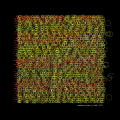Project idea
The environment we live in is full of different sounds: the noise of cars driving, the sound of birds singing and water flowing in the park, etc. If these sounds are transformed into graphics, how do they look visually different?
So in this project, the idealized approach is to catch different kinds of sounds in real time through wireless remote monitoring and sound sensors, and then translate them into graphics that people can ‚read‘.
Problem to be solved
Technical questions: How to show the electronics? Wireless remote monitoring? Radio transmitter/receiver for arduino?
Aesthetic questions: Why "circles"? Different forms for different sounds? How to present images?
Experiments
Experiment 4 ::: The purpose of this test is to solve the technical aspect of wireless transmission. After searching online, HC-12 Radio module could be a good solution for long distance transmission - about 1km, this makes it possible to collect and transmit the sound signals from different locations in this project. The test site of this time is still the balcony of student apartment near a traffic crossing. The process and the final generated graphic are as follows. HC-12 Module Connection Reference ::: [1]
Experiment 3 ::: In the third experiment, a combination of sound sensor and Processing was used to try to convert the sound in nature into graphic images. In this stage, I still chose circles as the basic elements of an image. At the beginning of the test, the collected changing sound values only affected the size of the circles, forming an image of overlapping circles. After that, the circles generated by each data were arranged sequentially on the canvas, just like "typing/ writing".
One sound sample is the bird song I recorded this summer in the woods below my student apartment. The other sound mimic are real-time car noises recorded from the balcony. Here are the patterns generated by those interesting moments. Video links ::: [2] [3] [4] [5]
Experiment 2 ::: The second improvement focused on the arrangement of the dots on the canvas, and I tried the "for loop" as recommended by the lecturer and got the following results. The size of the dots and the tone of the generated sound are determined by the input value of LDR in real time.
Experiment 1 ::: Learning Arduino for the first time and dealing with Light Dependent Resistor, briefly, the strength of the light projected onto LDR will directly affect the value of the output signal, so I want to make the dots on the screen change according to the changing value.
A small experiment: think of nature where sunlight is projected onto plants to create shadows, which move to create a changing value, and finally generate a screen image.











